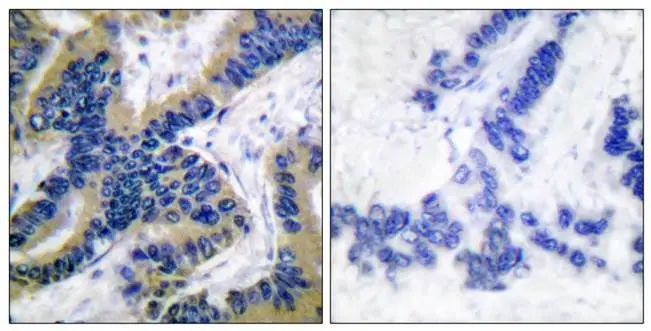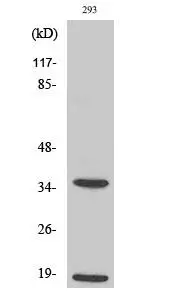
IHC-P analysis of human lung carcinoma tissue using GTX17383 Caspase 6 (Cleaved Asp179) antibody. The picture on the right is blocked with the synthesized peptide.
Caspase 6 (cleaved Asp179) antibody
GTX17383
ApplicationsWestern Blot, ImmunoHistoChemistry, ImmunoHistoChemistry Paraffin
Product group Antibodies
TargetCASP6
Overview
- SupplierGeneTex
- Product NameCaspase 6 (cleaved Asp179) antibody
- Delivery Days Customer9
- Application Supplier NoteWB: 1:500~1:1000. IHC-P: 1:50~1:100. *Optimal dilutions/concentrations should be determined by the researcher.Not tested in other applications.
- ApplicationsWestern Blot, ImmunoHistoChemistry, ImmunoHistoChemistry Paraffin
- CertificationResearch Use Only
- ClonalityPolyclonal
- ConjugateUnconjugated
- Gene ID839
- Target nameCASP6
- Target descriptioncaspase 6
- Target synonymsCSP-6, MCH2, caspase-6, caspase-6, apoptotic protease MCH-2, caspase 6, apoptosis-related cysteine peptidase, caspase 6, apoptosis-related cysteine protease, mammalian Ced-3 homologue 2
- HostRabbit
- IsotypeIgG
- Protein IDP55212
- Protein NameCaspase-6
- Scientific DescriptionThis gene encodes a protein which is a member of the cysteine-aspartic acid protease (caspase) family. Sequential activation of caspases plays a central role in the execution-phase of cell apoptosis. Caspases exist as inactive proenzymes which undergo proteolytic processing at conserved aspartic residues to produce two subunits, large and small, that dimerize to form the active enzyme. This protein is processed by caspases 7, 8 and 10, and is thought to function as a downstream enzyme in the caspase activation cascade. Alternative splicing of this gene results in two transcript variants that encode different isoforms. [provided by RefSeq, Jul 2008]
- Storage Instruction-20°C or -80°C,2°C to 8°C
- UNSPSC12352203







![ICC/IF analysis of C6 cells using GTX01097 Caspase 6 antibody [GT1154]. Orange: Primary antibody Blue: DAPI](https://www.genetex.com/upload/website/prouct_img/normal/GTX01097/GTX01097_20191101_AP_002_62_w_23053121_265.webp)
![ICC/IF analysis of NIH3T3 cells using GTX01098 Caspase 6 antibody [GT1155]. Orange: Primary antibody Blue: DAPI](https://www.genetex.com/upload/website/prouct_img/normal/GTX01098/GTX01098_20191101_AP_002_64_w_23053121_112.webp)
![IP analysis of Jurkat cell lysate using GTX17822 Caspase 6 antibody [3F52].](https://www.genetex.com/upload/website/prouct_img/normal/GTX17822/GTX17822_20191203_IP_31_w_23060620_418.webp)